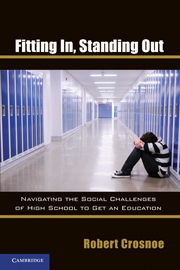Book contents
- Frontmatter
- Contents
- Acknowledgments
- PART I HIGH SCHOOLS AS CONTEXTS OF DEVELOPMENT
- PART II A CASE STUDY OF SOCIAL AND ACADEMIC EXPERIENCES IN HIGH SCHOOL
- 5 The Stakes of Social Marginalization
- 6 Teenagers at Particular Risk
- 7 How Teenagers Know What They Know and Why It Matters
- 8 Sources of Resilience
- PART III HELPING TEENAGERS NAVIGATE HIGH SCHOOL
- Works Cited
- Index
6 - Teenagers at Particular Risk
Published online by Cambridge University Press: 05 June 2012
- Frontmatter
- Contents
- Acknowledgments
- PART I HIGH SCHOOLS AS CONTEXTS OF DEVELOPMENT
- PART II A CASE STUDY OF SOCIAL AND ACADEMIC EXPERIENCES IN HIGH SCHOOL
- 5 The Stakes of Social Marginalization
- 6 Teenagers at Particular Risk
- 7 How Teenagers Know What They Know and Why It Matters
- 8 Sources of Resilience
- PART III HELPING TEENAGERS NAVIGATE HIGH SCHOOL
- Works Cited
- Index
Summary
If not fitting in socially during high school threatens the future educational trajectories of teenagers in an era in which the lifelong returns to college going are at an all-time high, then, for the purpose of policy intervention, we need to ask, who is at risk for feeling like they do not fit in at school? As with so many developmental issues, the answers to this seemingly straightforward question cross many domains of behavior, adjustment, status, and trait and vary a great deal by setting and context. Because I could not look into all of the reasons that teenagers might feel like they do not fit in socially at high school, I decided to couple theory with timely policy interests to narrow the focus.
In short, working from classic social psychological theory and with an eye toward major public health initiatives in the United States, I focused in general on the idea that some subsets of the population can carry social stigma and in particular on two groups that, historically, have been stigmatized: teenagers who are obese and teenagers who are lesbian/gay. Importantly, focusing on social stigma is true to the basic argument underlying the work presented so far; specifically, that teenagers may be affected by feelings of not fitting in whether those feelings “accurately” reflect their social positions or not.
- Type
- Chapter
- Information
- Fitting In, Standing OutNavigating the Social Challenges of High School to Get an Education, pp. 114 - 129Publisher: Cambridge University PressPrint publication year: 2011



